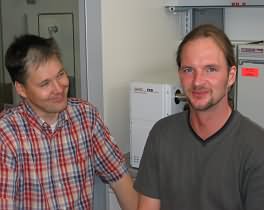The Department of Applied Atomic Spectroscopy / Innovative Analytical Instrumentation at the Institute for Inorganic and Analytical Chemistry of the University of Muenster (Germany) and the German company GERSTEL GmbH & Co.KG, Mülheim have developed a new detection system for elemental speciation by GC-PED.
A varying but often main part of mercury found in seafood is present as the chemical species methylmercury (MeHg+). Since methylmercury is much more toxic than inorganic mercury (HgII), the determination of the total amount of mercury e.g. in fish lacks the information about the most toxic compound. European legislation until now refers only to the total amount of mercury, set to the limit of 0.5 mg/kg wet weight (1.0 mg/kg for predatory fish) by EG 466/2001 (updated by EG 221/2002). Due to extensive studies of the Codex Alimentarius Commission (CAC) of the World Health Organisation (WHO) on the precise toxicity of methylmercury it is to be expected that especially this law will be changed in the near future.
To date, commercially available equipment for mercury speciation is usually based on inductively coupled plasmas with optical emission spectrometry (ICP-OES) or mass spectrometry (ICP-MS). These are doubtless highly sophisticated and very powerful techniques, but their major disadvantages are the high acquisition and operation costs.
In order to develop a convenient and fit-for-routine method for the GC-based analysis of mercury, lead and tin, W Buscher (University Münster, Germany) started the project

Automated Speciation Analyzer (ASA) in close cooperation with F. Adams (University of Antwerpen, Belgium) and R. Lobinski (University of Pau, France). Main objective was the development of a small, cost-effective, and robust speciation-analytical system based on gas chromatography coupled with a microwave-induced helium plasma excitation source as element selective detector. This instrument was planned to be especially dedicated to the speciation of mercury, lead, tin, and a few other elements.
Dr. Eike Kleine-Benne (right) and Dr. Wolfgang Buscher discussing technical details of the new Plasma Emission Detector (PED) in the laboratories of the University Münster

The German company GERSTEL GmbH & Co.KG, Mülheim, recognized the potential of the new instrument and seized the opportunity to check its analytical performance and its practicability. GERSTEL took up the ASA system and enhanced the technique, which resulted in the plasma emission detector (PED).
Right now, the prototype of the PED (see Photo left) is tested in the workgroup of W. Buscher at the University Münster. Introduction of the PED into the market is scheduled for 2006 after completion of final system optimization.
 Related Studies
Related Studies

M. Bradter,
Wolfgang H. Buscher, M. Faust, F. Winter, K. Cammann,
The plasma emission detector (PED) as an element-selective detector for high-resolution capillary gas chromatography, GIT Fachz. Lab., 33 (1989) 166-169.

D. Rieping,
Jörg Bettmer,
Wolfgang Buscher, K. Cammann,
Development of a simple gas chromatography detector based on atomic emission spectroscopy, GIT Fachz. Lab., 39/2 (1995) 95-98

Jörg Bettmer, M. Bradter,
Wolfgang Buscher, D. Erber, D. Rieping, K. Cammann,
GC-MIP-PED as an element-specific system for the determination of organomercury compounds, Appl. Organomet. Chem., 9/7 (1995) 541-545.
DOI: 10.1002/aoc.590090707
 Jörg Bettmer
Jörg Bettmer,
Wolfgang Buscher, K. Cammann,
Erste Untersuchungen zur Bestimmung von Organo-Hg-Verbindungen mit GC-MIP-PED, in: Bernhard Welz, CANAS'95 Colloquium Analytische Atomspektroskopie, Bodenseewerk Perkin-Elmer GmbH, Überlingen, ISSN 0945-2524, 1996, pp. 413-418
 Ryszard Lobinski
Ryszard Lobinski, V.O. Schmitt, I. Rodriguez Pereiro, A. Wasik,
Advances in Sample Preparation for Speciation Analysis - the Concept of an Automated Speciation Analyzer (ASA), in: Carla Vogt, Rainer Wennrich, Gerhard Werner, CANAS'97, Colloquium Analytische Atomspektroskopie, Universität Leipzig/UFZ Leipzig-Halle Leipzig, (ISSN 0945-2524) 1998, pp. 57-68

B. Rosenkranz, C.B. Breer,
Wolfgang Buscher, Jörg Bettmer, K. Cammann,
The plasma emission detector - a suitable detector for speciation and sum parameter analysis, J. Anal. At. Spectrom., 12/9 (1997) 993-996.
DOI: 10.1039/a701553d

Bernd Rosenkranz, Philippe Quevauviller, Joerg Bettmer,
Development of an automated speciation analyzer, Am. Lab. (Fairfield, Conn.), 31 (1999) 17-24.

Sofie Slaets, Freddy C. Adams,
Determination of organomercury compounds with a miniaturised automated speciation analyzer, Anal. Chim. Acta, 414/1-2 (2000) 141-149.
DOI: 10.1016/S0003-2670(00)00835-7

R. Feldhaus,
W. Buscher, E. Kleine-Benne, P. Quevauviller,
Development of a new automated speciation analyser - result of an international interdisciplinary co-operation between scientific and industrial partners, Trends Anal. Chem. (Pers. Ed.), 21/5 (2002) 356-365.
DOI: 10.1016/S0165-9936(02)00504-6
last time modified: October 15, 2024